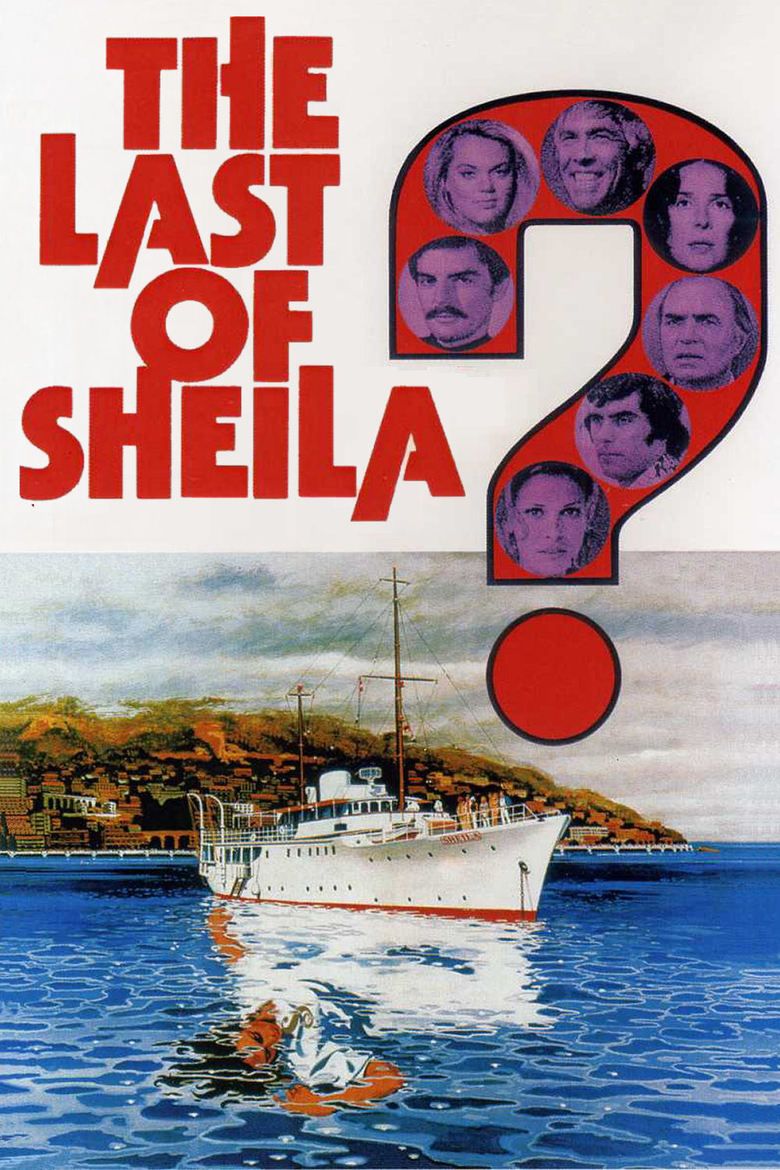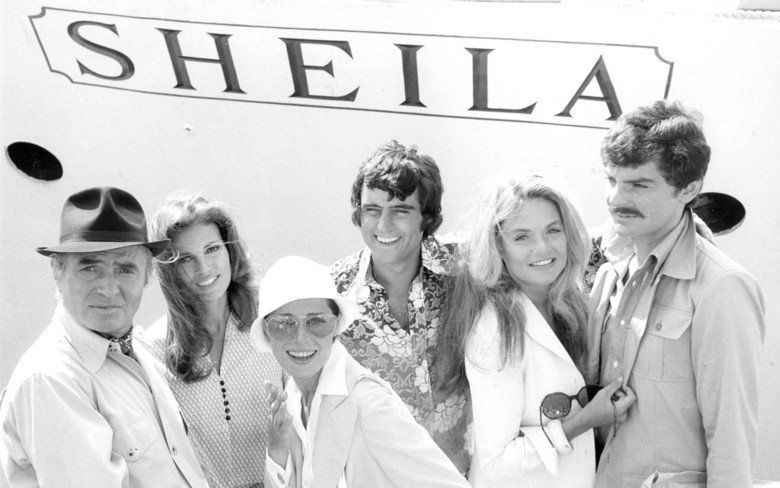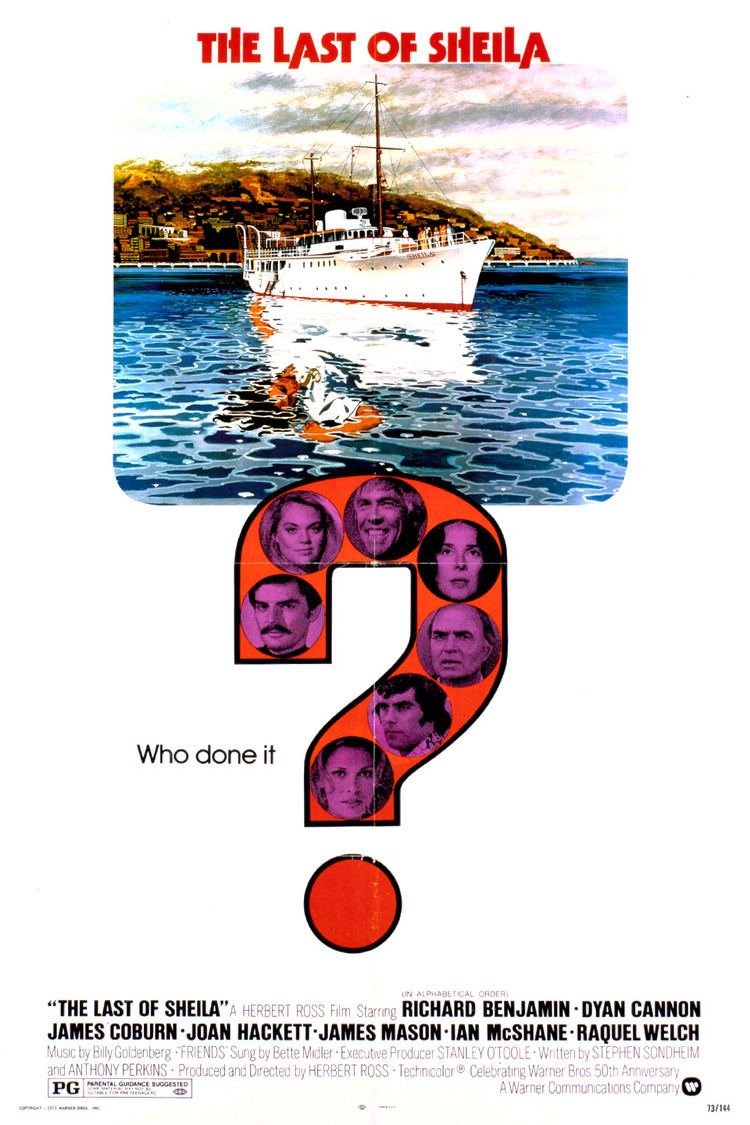The Last of Sheila
8.6 /10 1 Votes8.6
3.5/4 Roger Ebert 4.4/5 Amazon Genre Crime, Drama, Mystery Language English | 7.4/10 IMDb 92% Rotten Tomatoes Initial DVD release April 20, 2004 Duration Country United States | |||||||||||||||||||||||||||||||||
 | ||||||||||||||||||||||||||||||||||
Release date June 14, 1973 (1973-06-14) Cast (Tom), (Christine), (Clinton Green), (Lee), (Philip), (Anthony) Similar movies The Hunger Games: Catching Fire , Saw IV , The Talented Mr. Ripley , Overboard , Dead Calm , Survival Island Tagline Any number can play. Any number can die. | ||||||||||||||||||||||||||||||||||
The last of sheila 1973 trailer mp4
The Last of Sheila is a 1973 mystery thriller that was directed by Herbert Ross and written directly for the screen by Anthony Perkins and Stephen Sondheim. It starred Richard Benjamin, Dyan Cannon, James Coburn, Joan Hackett, James Mason, Ian McShane, and Raquel Welch.
Contents

The original music score was composed by Billy Goldenberg. The song "Friends," sung by Bette Midler, can be heard during the final scene of the film and the end credits.

Plot
On a one-week Mediterranean pleasure cruise aboard the yacht of movie producer Clinton Greene (Coburn), the guests include actress Alice Wood (Welch), her talent-manager husband Anthony (McShane), talent agent Christine (Cannon), screenwriter Tom Parkman (Benjamin), Tom's wife Lee (Hackett), and film director Philip Dexter (Mason).
The trip is, in fact, a reunion. All were together at Clinton's home one year before, on the night a hit-and-run accident resulted in the death of Clinton's wife, gossip columnist Sheila Greene. (Yvonne Romain, a former Hammer horror actress, appeared as Sheila Greene in a cameo performance.)
Once the cruise is under way, Clinton, a parlor game enthusiast, informs everyone that the week's entertainment will consist of "The Sheila Greene Memorial Gossip Game." The six guests are each assigned an index card containing a secret (in Clinton's words, "a pretend piece of gossip") that must be kept hidden from the others. The object of the game is to discover everyone else's secret while protecting one's own.
Each night the yacht anchors at a different Mediterranean port city, where one of the six secrets is disclosed to the entire group. The guests are given a clue, then sent ashore to find the proof of who among them holds the card bearing that night's secret. The game for that night ends when the actual holder of the subject secret discovers the proof. Anyone who has not yet solved the clue receives no points on Clinton's scoreboard for that round. Following the revelation of the first card, "YOU are a SHOPLIFTER," suspicion begins that each guest's card does not contain "pretend" gossip but in fact an actual, embarrassing secret about each guest.
When Clinton does not return from the second evening's installment of the game, where the second card was revealed to be "YOU are a HOMOSEXUAL," the guests return ashore and discover Clinton's corpse. Before contacting authorities, one reveals that his card reads, "YOU are a HIT-AND-RUN KILLER." This begins a macabre game of musical chairs of sorts, with guests jousting over who lays claim to which dirty little secret. Paranoia grows over the obvious implication that both Sheila and Clinton were killed by somebody on this yacht.
The game being played is actually just a portion of a more elaborate puzzle created by Clinton, including additional clues that are ever-present and the suggestion that any guest could win the game without even leaving the yacht, "If you're smart enough," Clinton taunted. Although his own diabolical game did not end as Clinton planned, characters continue to discover these clues, resulting in another death aboard the ship and the revelation of the identity of the guest who killed the host.
Cast
Production
The movie was inspired by an irregular series of elaborate, real-life scavenger hunts Sondheim and Perkins arranged for their show business friends (including Lee Remick and George Segal) in Manhattan in the late 1960s and early 1970s. Herb Ross also took part in the treasure hunts with his wife Norma; he says one of the clues was spelt out by icing on a cake which had been cut up into different pieces.
The climax of one hunt was staged in the lobby of a seedy flophouse, where participants heard a skipping LP record endlessly repeating the first line of the Harold Arlen/Johnny Mercer standard One for My Baby ("It's quarter to three ... It's quarter to three ..."). The winning team eventually recognized the clue—2:45—and immediately headed for room 245 of the hotel, where bottles of Champagne awaited them.
Sondheim later recalled:
The idea for the movie grew out of two murder games I devised some time ago. One was for Phyllis Newman; the other for four couples just after I got out of college. A murder game? No, nobody gets murdered. With the four couples, I told each person to think of a way to kill one of the others over the weekend we would be spending together in the country. Then we passed out envelopes and inside one was an 'X'. That person was the only one who was to carry out his plan; the others were to spend the time avoiding being murdered.
Herb Ross made the film for his own production company; it was distributed by Warner Bros. Ross:
If you have a group of people on a ship, the ship becomes a metaphor for existence, you can't help it. It's not a symbol one strives for, but it does happen. It's not a picture about film people, it's about people... I'll tell you what this picture is about. It's about civilisation and barbarism. You cannot make up for the absence of civilisation.
Casting
Stephen Sondheim said he and Perkins "thought of the secrets before the characters". The Dyan Cannon character was based on talent agent Sue Mengers.
Herbert Ross originally offered the role to Mengers herself, but she turned it down, claiming too many of her clients were out of work. Instead she pitched her client, Dyan Cannon, for the part. "But they came and took pictures of my office to see what a lady agent's office looks like," says Mengers. "It's filled with ferns and plants. They want to construct a set just like it over in Nice."
Cannon later said she did not want to do the film at first as she did not like the part on the page - "the script seemed too broad, everybody caricaturised, especially my part. I mean, Sue Mengers is wild, but not that wild. There seemed to be no humanity in the women's roles." However she says Mengers talked her into it as "it'll be a chance to show them you've got something more than your obvious assets". Cannon gained 19 pounds to play the role. She said the part was "finally changed, deepened. I still had to bring a lot to it, and I think the result's unlike anything I've ever done."
James Mason played a washed-up film director, who was reportedly based on two real life directors. "Steve and Tony insist they wrote the part for me," said Mason. "If they did, they did it for a ready-made image. If the passé director is played by someone who makes constant appearances on The Late, Late Show, it helps. Consequently I'm playing it as everybody's idea of James Mason."
Raquel Welch played a movie starlet and Ian McShane her manager-husband. Welch said the two were based on Ann-Margret and her husband Roger Smith but Sondheim later said the part was actually based on Welch herself and her one time husband Patrick Curtis.
Shooting
The movie was shot in the south of France. In an interview for a fortieth-anniversary screening of the film, Cannon said that filming on an actual yacht proved to be too difficult, and so production was halted, stranding the cast on location: "So we had to wait in the south of France while they built a set at the Victorine Studios [in Nice] for us. We had to spend our days lying on the beach and going to lunch and shopping. It was a hard job!"
The shoot was not easy; according to Dyan Cannon the first cameraman was fired and the yacht sank. There were also complaints about Raquel Welch's behaviour. In turn, she announced she was suing Herbert Ross for assault and battery as a result of an incident in her dressing room. She claimed she had to flee to London during the shoot "to escape physical harm". However she then returned to Nice to shoot the film's final scenes, although she was provided with a bodyguard. Warner Bros.later issued a statement supporting Ross and criticising Welch for her "public utterances".
James Mason told a newspaper at the time that Welch was "the most selfish, ill-mannered, inconsiderate actress that I've ever had the displeasure of working with."
Joel Schumacher worked on the film as costume designer.
Reception
Perkins and Sondheim's script was novelized by Alexander Edwards. The critical reception for the film was mostly positive. The film currently holds a 92% rating on Rotten Tomatoes based on 12 reviews. In The New York Times Vincent Canby called the film "an old-fashioned murder mystery" that "makes murder, as well as life, more interesting." Raquel Welch later said she was "good" in the film "but being good in a bad movie doesn't do anything for your career."
Follow-up
In 1975 Tony Perkins said he and Sondheim were working on another script, The Chorus Girl Murder Case. "It's a sort of stew based on all those Bob Hope wartime comedies, plus a little Lady of Burlesque and a little Orson Welles magic show, all cooked into a Last of Sheila-type plot," said Perkins. He later said other inspirations were They Got Me Covered, The Ipcress File and Cloak and Dagger. However, the film was never made.
In the 1980s Perkins and Sondheim collaborated on another script, the seven part Crime and Variations for Motown Productions. It too was never made.
References
The Last of Sheila WikipediaThe Last of Sheila IMDbThe Last of Sheila Roger EbertThe Last of Sheila Rotten TomatoesThe Last of Sheila Amazon.comThe Last of Sheila themoviedb.org
